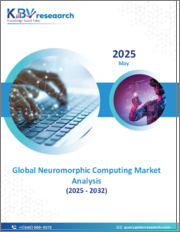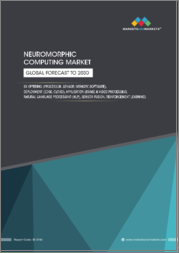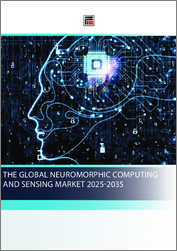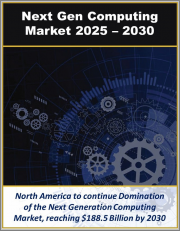
|
시장보고서
상품코드
1715789
뉴로모픽 컴퓨팅 시장 : 오퍼링, 컴퓨팅 모델, 애플리케이션, 배포, 최종사용자별 - 세계 예측(2025-2030년)Neuromorphic Computing Market by Offering, Computing Models, Application, Deployment, End-Users - Global Forecast 2025-2030 |
||||||
뉴로모픽 컴퓨팅 시장의 2023년 시장 규모는 19억 1,000만 달러로, 2024년에는 23억 3,000만 달러, CAGR 24.92%로 성장하며, 2030년에는 90억 9,000만 달러에 달할 것으로 예측됩니다.
| 주요 시장 통계 | |
|---|---|
| 기준연도 2023 | 19억 1,000만 달러 |
| 추정연도 2024 | 23억 3,000만 달러 |
| 예측연도 2030 | 90억 9,000만 달러 |
| CAGR(%) | 24.92% |
뉴로모픽 컴퓨팅은 현대 컴퓨팅 시스템의 설계와 기능에서 획기적인 진화를 의미합니다. 인간 두뇌의 신경 아키텍처를 모방함으로써 이 기술은 더 빠를 뿐만 아니라 실시간으로 학습하고 적응할 수 있는 시스템으로 가는 길을 열어가고 있습니다. 기존의 폰 노이만 아키텍처에서 바이오 인스파이어드 모델로의 패러다임 전환은 처리 효율과 에너지 소비에 새로운 가능성을 가져다주었습니다. 최근 하드웨어와 소프트웨어의 발전은 뉴로모픽 원리의 채택을 가속화하여 다양한 용도에서 보다 직관적인 데이터 처리를 가능하게 하고 있습니다. 연구자 및 업계 전문가들은 단순화된 계산 모델을 사용하여 복잡한 작업을 처리할 수 있는 이 기술을 높이 평가하고 있으며, 그 결과 인공지능에서 로봇 공학에 이르기까지 다양한 분야에서 혁신을 촉진하고 있습니다. 뉴로모픽 컴퓨팅의 통합이 경쟁 구도를 재정의하고 디지털 전환의 새로운 시대를 주도할 수 있다는 것을 인식하고, 시장이 발전함에 따라 다양한 업계의 이해관계자들이 이러한 진전을 주시하고 있습니다. 센서 설계에서 컴퓨팅 코어에 이르기까지 모든 것을 혁신할 수 있는 잠재력을 지닌 뉴로모픽 컴퓨팅은 차세대 기술 솔루션의 유망한 이정표가 되고 있습니다.
이 과학이 성숙함에 따라 신경 역학 및 적응 처리의 추가 통합은 미래의 스마트 시스템을 지원하고 상업 및 산업 분야 모두에서 변화의 무대가 될 것으로 예측됩니다.
뉴로모픽 컴퓨팅 시장의 변화
지난 수년간 뉴로모픽 컴퓨팅의 상황은 기존 컴퓨팅 패러다임에 도전하는 혁신적인 변화를 목격했습니다. 생물에서 영감을 얻은 아키텍처를 활용하여 특수 하드웨어와 첨단 소프트웨어 프레임워크가 모두 개발되었으며, 시장 개발이 빠르게 진행되고 있습니다. 회로 설계와 재료 과학의 혁신은 생물학적 뇌의 시냅스 기능을 모방한 적응형 프로세서를 탄생시켰습니다. 이러한 혁신은 고립된 것이 아니라 효율성, 적응성, 속도를 최우선으로 하는 컴퓨팅의 시너지적 재구축을 의미합니다. 기존의 데이터 처리 방식은 동적 학습 기능과 직관적인 의사결정 프로세스를 통합한 시스템으로 대체되고 있습니다. 제조업체들은 자율주행차나 의료 진단과 같은 중요한 환경에서 실시간으로 의사결정을 내릴 수 있는 시스템을 구축하기 위해 센서와 프로세서의 통합에 점점 더 집중하고 있습니다.
또한 중앙집중형 환경과 분산형 환경 모두에서 작동하는 솔루션에 대한 수요가 증가하고 있습니다. 이러한 기술을 클라우드 및 엣지 환경에서 유연하게 배포할 수 있는 유연성은 경쟁 차별화 요소로 빠르게 중요해지고 있습니다. 전자공학에서 인지과학에 이르기까지 현재 진행 중인 다학제적 기술 융합은 뉴로모픽 컴퓨팅을 미래 혁신과 파괴의 중요한 원동력으로 자리매김하는 패러다임의 전환을 촉진하고 있습니다.
뉴로모픽 컴퓨팅의 주요 부문 분석
뉴로모픽 컴퓨팅 시장을 종합적으로 분석하면 역동적인 상황을 형성하는 몇 가지 중요한 세분화 관점이 드러납니다. 먼저, 시장은 뉴로모픽 하드웨어와 소프트웨어에 초점을 맞춘 조사를 통해 제공되는 제품에 따라 세분화됩니다. 하드웨어 영역에서는 시스템의 효율성과 정확성을 지원하는 뉴로모픽 프로세서와 센서에 특별한 주의를 기울이고 있습니다. 물리적 구성 요소의 틀을 넘어 컴퓨팅 모델에 기반한 세분화를 통해 풍부한 시뮬레이션 프레임워크가 발견되었습니다. 동적 시냅스 모델부터 FitzHugh-Nagumo 모델, Hodgkin-Huxley 모델, Izhikevich 모델, Leaky Integrate-and-Fire 모델, 심지어 스파이크 신경망 구현에 이르기까지 이러한 접근법은 신경행동 에뮬레이션에 대한 귀중한 인사이트를 제공합니다.
또한 용도별로 세분화하여 데이터 처리, 이미지 처리, 물체 감지, 신호 처리 등의 주요 이용 사례를 통해 뉴로모픽 설계의 다양성과 견고성을 보여줍니다. 배포 세분화에서는 솔루션이 클라우드 기반과 엣지 환경 모두에 어떻게 적용되어 확장성과 범용성을 보장하는지를 강조합니다. 마지막으로 최종사용자별 세분화는 항공우주 및 방위, 자동차 및 운송, 은행, 금융서비스 및 보험(BFSI), 가전, 에너지, 헬스케어 및 의료기기, IT 및 통신, 제조 등 다양한 산업군에 걸쳐 있습니다. 이러한 세분화에 대한 인사이트는 시장 동향을 파악할 수 있을 뿐만 아니라, 뉴로모픽 컴퓨팅에 대한 소비자의 요구와 기술적 능력의 진화에 대한 미묘한 이해를 제공합니다.
목차
제1장 서문
제2장 조사 방법
제3장 개요
제4장 시장 개요
제5장 시장 인사이트
- 시장 역학
- 성장 촉진요인
- 성장 억제요인
- 기회
- 해결해야 할 과제
- 시장 세분화 분석
- Porter’s Five Forces 분석
- PESTLE 분석
- 정치
- 경제
- 사회
- 기술
- 법률
- 환경
제6장 뉴로모픽 컴퓨팅 시장 : 제공별
- 뉴로모픽 하드웨어
- 뉴로모픽 프로세서
- 센서
- 소프트웨어
제7장 뉴로모픽 컴퓨팅 시장 : 계산 모델별
- 동적 시냅스 모델
- FitzHugh-Nagumo Model
- Hodgkin-Huxley Model
- Izhikevich Model
- Leaky Integrate-and-Fire Model
- 스파이킹 뉴널 네트워크
제8장 뉴로모픽 컴퓨팅 시장 : 용도별
- 데이터 처리
- 영상 처리
- 물체 탐지
- 신호 처리
제9장 뉴로모픽 컴퓨팅 시장 : 배포별
- 클라우드
- Edge
제10장 뉴로모픽 컴퓨팅 시장 : 최종사용자별
- 항공우주 및 방위
- 자동차·운송
- BFSI
- 가전
- 에너지
- 헬스케어 및 의료기기
- IT·통신
- 제조업
제11장 아메리카의 뉴로모픽 컴퓨팅 시장
- 아르헨티나
- 브라질
- 캐나다
- 멕시코
- 미국
제12장 아시아태평양의 뉴로모픽 컴퓨팅 시장
- 호주
- 중국
- 인도
- 인도네시아
- 일본
- 말레이시아
- 필리핀
- 싱가포르
- 한국
- 대만
- 태국
- 베트남
제13장 유럽, 중동 및 아프리카의 뉴로모픽 컴퓨팅 시장
- 덴마크
- 이집트
- 핀란드
- 프랑스
- 독일
- 이스라엘
- 이탈리아
- 네덜란드
- 나이지리아
- 노르웨이
- 폴란드
- 카타르
- 러시아
- 사우디아라비아
- 남아프리카공화국
- 스페인
- 스웨덴
- 스위스
- 튀르키예
- 아랍에미리트
- 영국
제14장 경쟁 구도
- 시장 점유율 분석, 2023
- FPNV 포지셔닝 매트릭스, 2023
- 경쟁 시나리오 분석
- 전략 분석과 제안
기업 리스트
- aiMotive by Stellantis N.V.
- Applied Brain Research
- Aspinity, Inc.
- BrainChip, Inc.
- Chengdu SynSense Technology Co., Ltd
- DEEPX
- General Vision Inc.
- Hailo Technologies Ltd.
- Hewlett Packard Enterprise Company
- Imec International
- iniLabs Ltd.
- Innatera Nanosystems BV
- Intel Corporation
- International Business Machines Corporation
- Kneron, Inc.
- MediaTek Inc.
- Mythic, Inc.
- Numenta, Inc.
- Prophesee S.A.
- Qualcomm Technologies, Inc.
- Robert Bosch GmbH
- Samsung Electronics Co., Ltd.
- SK Hynix Inc.
- SpiNNcloud Systems GmbH
- Syntiant Corp.
- Toshiba Corporation
The Neuromorphic Computing Market was valued at USD 1.91 billion in 2023 and is projected to grow to USD 2.33 billion in 2024, with a CAGR of 24.92%, reaching USD 9.09 billion by 2030.
| KEY MARKET STATISTICS | |
|---|---|
| Base Year [2023] | USD 1.91 billion |
| Estimated Year [2024] | USD 2.33 billion |
| Forecast Year [2030] | USD 9.09 billion |
| CAGR (%) | 24.92% |
Neuromorphic computing represents a groundbreaking evolution in the design and function of modern computing systems. By mimicking the neural architecture of the human brain, this technology is paving the way for systems that are not only faster but also capable of learning and adapting in real time. The paradigm shifts away from traditional von Neumann architectures towards bio-inspired models have opened up new possibilities in processing efficiency and energy consumption. Recent developments in both hardware and software have accelerated the adoption of neuromorphic principles, enabling more intuitive data processing across various applications. Researchers and industry experts commend the technology for its ability to process complex tasks using simplified computational models, which in turn fosters innovation across domains from artificial intelligence to robotics. As the market evolves, stakeholders from multiple industries are keenly observing these advances, recognizing that the integration of neuromorphic computing could redefine competitive landscapes and drive a new era of digital transformation. With its potential to revolutionize everything from sensor designs to computing cores, neuromorphic computing stands as a beacon of promise in next-generation technology solutions.
As the science matures, further integration of neural dynamics and adaptive processing is expected to underpin future smart systems, setting the stage for transformative changes in both commercial and industrial segments.
Transformative Shifts in the Neuromorphic Landscape
Over the past few years, the neuromorphic computing landscape has witnessed transformative shifts that challenge conventional computing paradigms. Leveraging bio-inspired architectures, the market is rapidly evolving with developments in both specialized hardware and advanced software frameworks. Innovations in circuit design and materials science have given rise to adaptable processors that mimic the synaptic functionality of biological brains. These breakthroughs are not isolated; they represent a synergistic reimagining of computing where efficiency, adaptability, and speed are paramount. Traditional data processing methods have been replaced by systems that incorporate dynamic learning capabilities and intuitional decision-making processes. Manufacturers are increasingly focused on integrating sensors and processors that work in tandem, creating systems that can make real-time decisions in critical environments such as autonomous vehicles or medical diagnostics.
Furthermore, the demand for solutions that can operate in both centralized and distributed environments is increasing. The flexibility to deploy these technologies in cloud and edge settings is rapidly becoming a key competitive differentiator. The ongoing convergence of interdisciplinary technologies, ranging from electronics to cognitive sciences, is fueling a paradigm shift that positions neuromorphic computing as a key driver of future innovation and disruption.
Key Segmentation Insights in Neuromorphic Computing
A comprehensive analysis of the neuromorphic computing market reveals several critical segmentation perspectives that shape its dynamic landscape. The market is first segmented based on offering, with investigations focusing on neuromorphic hardware and software. Within the hardware domain, special attention is given to neuromorphic processors and sensors, both of which underpin system efficiency and accuracy. Moving beyond physical components, segmentation based on computing models uncovers a rich array of simulation frameworks. From dynamic synapse models to implementations of the FitzHugh-Nagumo, Hodgkin-Huxley, Izhikevich, and Leaky Integrate-and-Fire models, as well as spiking neural networks, these approaches provide valuable insights into the emulation of neural behaviors.
Furthermore, segmentation by application has illuminated key use cases such as data processing, image processing, object detection, and signal processing, each illustrating the versatility and robustness of neuromorphic designs. The deployment segmentation highlights how solutions are adapted for both cloud-based and edge environments, ensuring scalability and versatility. Lastly, the segmentation by end-users spans a diverse array of industries including aerospace and defense, automotive and transportation, BFSI, consumer electronics, energy, healthcare and medical devices, IT and telecommunications, and manufacturing. Together, these segmentation insights not only clarify market trends but also offer a nuanced understanding of evolving consumer demands and technological capabilities in neuromorphic computing.
Based on Offering, market is studied across Neuromorphic Hardware and Software. The Neuromorphic Hardware is further studied across Neuromorphic Processor and Sensor.
Based on Computing Models, market is studied across Dynamic Synapse Models, FitzHugh-Nagumo Model, Hodgkin-Huxley Model, Izhikevich Model, Leaky Integrate-and-Fire Model, and Spiking Neural Networks.
Based on Application, market is studied across Data Processing, Image Processing, Object Detection, and Signal Processing.
Based on Deployment, market is studied across Cloud and Edge.
Based on End-Users, market is studied across Aerospace & Defense, Automotive & Transportation, BFSI, Consumer Electronics, Energy, Healthcare & Medical Devices, IT & Telecommunications, and Manufacturing.
Key Regional Insights into Global Developments
The international neuromorphic computing market is characterized by diverse regional trends that reflect varying adoption rates and technological capabilities. In the Americas, robust investments in research and development coupled with strong industrial collaborations are propelling forward-thinking initiatives that are quickly translating into commercial applications. Meanwhile, the Europe, Middle East & Africa region is marked by a strategic focus on next-generation technologies, with public-private partnerships driving innovation across multiple sectors and a commitment to regulatory-friendly ecosystems. The Asia-Pacific region stands out due to rapid economic growth and a surge in technological experimentation, where leading nations are investing heavily in both academic and industrial research. This region is rapidly becoming a global hub for pioneering work in neuromorphic hardware and software integrations.
These regional insights underscore the fact that, regardless of geography, stakeholders must navigate distinct market dynamics, regulatory environments, and consumer expectations. The interplay between local strengths and global trends is catalyzing cross-border collaborations and accelerating the diffusion of neuromorphic technologies worldwide, ultimately paving the way for a more interconnected and efficient future in computing.
Based on Region, market is studied across Americas, Asia-Pacific, and Europe, Middle East & Africa. The Americas is further studied across Argentina, Brazil, Canada, Mexico, and United States. The United States is further studied across California, Florida, Illinois, New York, Ohio, Pennsylvania, and Texas. The Asia-Pacific is further studied across Australia, China, India, Indonesia, Japan, Malaysia, Philippines, Singapore, South Korea, Taiwan, Thailand, and Vietnam. The Europe, Middle East & Africa is further studied across Denmark, Egypt, Finland, France, Germany, Israel, Italy, Netherlands, Nigeria, Norway, Poland, Qatar, Russia, Saudi Arabia, South Africa, Spain, Sweden, Switzerland, Turkey, United Arab Emirates, and United Kingdom.
Key Companies Pioneering Neuromorphic Innovations
The competitive landscape within neuromorphic computing is both diverse and dynamic with a range of established names and emerging startups pushing the boundaries of technology. Leading companies such as aiMotive by Stellantis N.V. and Applied Brain Research are at the forefront with innovative research that bridges the gap between theoretical potential and practical application. Firms like Aspinity, Inc. and BrainChip, Inc. have been instrumental in the commercialization of advanced neural architectures, while Chengdu SynSense Technology Co., Ltd and DEEPX contribute significantly to the hardware advancements that power real-time data processing.
Notable players including General Vision Inc. and Hailo Technologies Ltd. complement these efforts by merging deep learning algorithms with next-generation sensor technologies. Industry giants such as Hewlett Packard Enterprise Company, Imec International, and Intel Corporation continue to invest in neuromorphic platforms that enhance system integration and scalability, in tandem with International Business Machines Corporation and Kneron, Inc. who are vocal proponents of sustainable and adaptive computing. MediaTek Inc. and Mythic, Inc. are known for integrating robust software solutions into neuromorphic processors, while Numenta, Inc. and Prophesee S.A. offer deep insights into algorithmic efficiencies that mirror biological processing. Furthermore, established technology leaders like Qualcomm Technologies, Inc., Robert Bosch GmbH, and Samsung Electronics Co., Ltd. are strategically positioning themselves within this domain.
Additional key players such as SK Hynix Inc., SpiNNcloud Systems GmbH, Syntiant Corp., and Toshiba Corporation further bolster market competitiveness by continuously driving innovation and expanding the boundary of what is technologically possible. Their collective contributions offer a well-rounded view of market trends, ensuring that the ecosystem remains vibrant and forward-thinking.
The report delves into recent significant developments in the Neuromorphic Computing Market, highlighting leading vendors and their innovative profiles. These include aiMotive by Stellantis N.V., Applied Brain Research, Aspinity, Inc., BrainChip, Inc., Chengdu SynSense Technology Co., Ltd, DEEPX, General Vision Inc., Hailo Technologies Ltd., Hewlett Packard Enterprise Company, Imec International, iniLabs Ltd., Innatera Nanosystems BV, Intel Corporation, International Business Machines Corporation, Kneron, Inc., MediaTek Inc., Mythic, Inc., Numenta, Inc., Prophesee S.A., Qualcomm Technologies, Inc., Robert Bosch GmbH, Samsung Electronics Co., Ltd., SK Hynix Inc., SpiNNcloud Systems GmbH, Syntiant Corp., and Toshiba Corporation. Actionable Recommendations for Industry Leaders
For decision-makers and industry pioneers, the current landscape of neuromorphic computing presents both opportunities and challenges that require strategic foresight. It is imperative to prioritize continued investment in research and development to stay ahead of rapid technological advancements. Leaders should consider forming strategic partnerships with research institutions to jointly explore emerging neuromorphic models and their potential real-world applications. Beyond technology development, embracing a customer-centric approach that focuses on measurable improvements in efficiency, power consumption, and system adaptability can differentiate one's offerings in a competitive market.
Furthermore, companies should explore diverse deployment strategies, by leveraging both cloud and edge solutions to optimize performance across different use cases. A holistic integration of advanced computing models-from dynamic synapse configurations to spiking neural networks-will enable organizations to harness the full capabilities of bio-inspired systems. Engaging early with regulatory bodies and establishing frameworks for compliance can also mitigate potential risks associated with technological innovations. Overall, a balanced approach that drives both technology enhancement and market penetration will position industry leaders for sustained success in the evolving landscape of neuromorphic computing.
Conclusion and Future Outlook
The executive summary of neuromorphic computing underscores an industry at the cusp of a major technological renaissance. The converging trends in hardware and software innovations, coupled with deep integration of bio-inspired models, present a transformative opportunity for industries worldwide. This surge in innovation is not only redefining the way computing systems are conceived but also setting a new benchmark for efficiency and adaptive learning. As the market segments diversify and regional initiatives strengthen, the promise of neuromorphic computing is becoming increasingly clear and compelling.
Looking forward, stakeholders must remain agile and forward-thinking, investing in novel architectures and aligning product strategies with emerging market demands. The capacity to seamlessly integrate advanced computing models into practical applications will be a key determinant of success. Ultimately, the journey toward fully realizing the potential of neuromorphic computing is driven by relentless innovation, collaborative spirit, and an unwavering commitment to excellence in technology and customer service.
Table of Contents
1. Preface
- 1.1. Objectives of the Study
- 1.2. Market Segmentation & Coverage
- 1.3. Years Considered for the Study
- 1.4. Currency & Pricing
- 1.5. Language
- 1.6. Stakeholders
2. Research Methodology
- 2.1. Define: Research Objective
- 2.2. Determine: Research Design
- 2.3. Prepare: Research Instrument
- 2.4. Collect: Data Source
- 2.5. Analyze: Data Interpretation
- 2.6. Formulate: Data Verification
- 2.7. Publish: Research Report
- 2.8. Repeat: Report Update
3. Executive Summary
4. Market Overview
5. Market Insights
- 5.1. Market Dynamics
- 5.1.1. Drivers
- 5.1.1.1. Growing advancements in artificial intelligence and machine learning
- 5.1.1.2. Increasing integration of smart sensors and IoT devices is enhancing the utility and adoption of neuromorphic systems
- 5.1.2. Restraints
- 5.1.2.1. Data security and privacy concerns along with software compatibility issues with existing digital architectures in neuromorphic devices
- 5.1.3. Opportunities
- 5.1.3.1. Government and private funding in neuromorphic research
- 5.1.3.2. Collaborations and partnerships between tech giants and research organizations are propelling innovations in neuromorphic computing
- 5.1.3.3. Emergence of neuromorphic architectures in gaming for lifelike virtual experiences
- 5.1.4. Challenges
- 5.1.4.1. Lack of standardized benchmarks for neuromorphic computing performance evaluation with confined accessibility
- 5.1.1. Drivers
- 5.2. Market Segmentation Analysis
- 5.2.1. Computing Models: Growing adoption of neuromorphic computing's Hodgkin-Huxley model in the biomedical sector
- 5.2.2. Offering: Burgeoning usage of the software enhances the process by configuring adaptable neural networks and optimizing algorithms for specific applications
- 5.2.3. Application: Expanding application of neuromorphic computing in data processing
- 5.2.4. Deployment: Significant edge-based deployment of neuromorphic computing
- 5.2.5. End-Users: Rising usage of the neuromorphic-computing in consumer electronics
- 5.3. Porter's Five Forces Analysis
- 5.3.1. Threat of New Entrants
- 5.3.2. Threat of Substitutes
- 5.3.3. Bargaining Power of Customers
- 5.3.4. Bargaining Power of Suppliers
- 5.3.5. Industry Rivalry
- 5.4. PESTLE Analysis
- 5.4.1. Political
- 5.4.2. Economic
- 5.4.3. Social
- 5.4.4. Technological
- 5.4.5. Legal
- 5.4.6. Environmental
6. Neuromorphic Computing Market, by Offering
- 6.1. Introduction
- 6.2. Neuromorphic Hardware
- 6.2.1. Neuromorphic Processor
- 6.2.2. Sensor
- 6.3. Software
7. Neuromorphic Computing Market, by Computing Models
- 7.1. Introduction
- 7.2. Dynamic Synapse Models
- 7.3. FitzHugh-Nagumo Model
- 7.4. Hodgkin-Huxley Model
- 7.5. Izhikevich Model
- 7.6. Leaky Integrate-and-Fire Model
- 7.7. Spiking Neural Networks
8. Neuromorphic Computing Market, by Application
- 8.1. Introduction
- 8.2. Data Processing
- 8.3. Image Processing
- 8.4. Object Detection
- 8.5. Signal Processing
9. Neuromorphic Computing Market, by Deployment
- 9.1. Introduction
- 9.2. Cloud
- 9.3. Edge
10. Neuromorphic Computing Market, by End-Users
- 10.1. Introduction
- 10.2. Aerospace & Defense
- 10.3. Automotive & Transportation
- 10.4. BFSI
- 10.5. Consumer Electronics
- 10.6. Energy
- 10.7. Healthcare & Medical Devices
- 10.8. IT & Telecommunications
- 10.9. Manufacturing
11. Americas Neuromorphic Computing Market
- 11.1. Introduction
- 11.2. Argentina
- 11.3. Brazil
- 11.4. Canada
- 11.5. Mexico
- 11.6. United States
12. Asia-Pacific Neuromorphic Computing Market
- 12.1. Introduction
- 12.2. Australia
- 12.3. China
- 12.4. India
- 12.5. Indonesia
- 12.6. Japan
- 12.7. Malaysia
- 12.8. Philippines
- 12.9. Singapore
- 12.10. South Korea
- 12.11. Taiwan
- 12.12. Thailand
- 12.13. Vietnam
13. Europe, Middle East & Africa Neuromorphic Computing Market
- 13.1. Introduction
- 13.2. Denmark
- 13.3. Egypt
- 13.4. Finland
- 13.5. France
- 13.6. Germany
- 13.7. Israel
- 13.8. Italy
- 13.9. Netherlands
- 13.10. Nigeria
- 13.11. Norway
- 13.12. Poland
- 13.13. Qatar
- 13.14. Russia
- 13.15. Saudi Arabia
- 13.16. South Africa
- 13.17. Spain
- 13.18. Sweden
- 13.19. Switzerland
- 13.20. Turkey
- 13.21. United Arab Emirates
- 13.22. United Kingdom
14. Competitive Landscape
- 14.1. Market Share Analysis, 2023
- 14.2. FPNV Positioning Matrix, 2023
- 14.3. Competitive Scenario Analysis
- 14.3.1. Seoul National University unveils ultra-low power neuromorphic hardware advancing AI Computation
- 14.3.2. MediaTek launches Dimensity 9400 chip enhancing AI, gaming, and efficiency to rival Qualcomm's leadership
- 14.3.3. IISc scientists are transforning data processing with neuromorphic computing technology
- 14.3.4. Innatera's USD 21 million Series enehnces edge AI with Spiking Neural Processor T1
- 14.3.5. Ultraleap, Prophesee, and TCL RayNeo redefine usability with low-power neuromorphic systems
- 14.3.6. Intel's advancements at Computex 2024 redefine AI integration and power efficiency with new processor releases
- 14.3.7. Launch of SpiNNaker2 marks a new era in neuromorphic computing for scalable and energy-efficient AI solutions
- 14.3.8. Intel unveils Hala Point to reshape AI with unprecedented neuromorphic capabilities for efficiency
- 14.3.9. SynSense and iniVation merger creates powerful neuromorphic leader driving innovation in intelligent vision technologies across diverse markets
- 14.3.10. Innatera's Spiking Neural Processor T1 revolutionizes ultra-low power AI for sensor-edge applications at CES 2024
- 14.4. Strategy Analysis & Recommendation
- 14.4.1. MediaTek Inc.
- 14.4.2. PROPHESEE S.A.
- 14.4.3. Intel Corporation
- 14.4.4. Innatera Nanosystems
Companies Mentioned
- 1. aiMotive by Stellantis N.V.
- 2. Applied Brain Research
- 3. Aspinity, Inc.
- 4. BrainChip, Inc.
- 5. Chengdu SynSense Technology Co., Ltd
- 6. DEEPX
- 7. General Vision Inc.
- 8. Hailo Technologies Ltd.
- 9. Hewlett Packard Enterprise Company
- 10. Imec International
- 11. iniLabs Ltd.
- 12. Innatera Nanosystems BV
- 13. Intel Corporation
- 14. International Business Machines Corporation
- 15. Kneron, Inc.
- 16. MediaTek Inc.
- 17. Mythic, Inc.
- 18. Numenta, Inc.
- 19. Prophesee S.A.
- 20. Qualcomm Technologies, Inc.
- 21. Robert Bosch GmbH
- 22. Samsung Electronics Co., Ltd.
- 23. SK Hynix Inc.
- 24. SpiNNcloud Systems GmbH
- 25. Syntiant Corp.
- 26. Toshiba Corporation



















